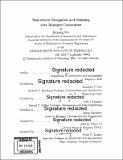Task-driven navigation and mapping with resource constraints
Author(s)
Mu, Beipeng
DownloadFull printable version (13.22Mb)
Other Contributors
Massachusetts Institute of Technology. Department of Aeronautics and Astronautics.
Advisor
Jonathan P. How.
Terms of use
Metadata
Show full item recordAbstract
Breakthroughs in sensing technology in the past decade have greatly improved the capability of robots to sense complicated, partially-known environments. For example, RGB-D cameras and Velodyne scanners allow for the collection of massive amounts of sensor data in real time. These new technologies enable many new possibilities for mobile robots, such as driverless cars, drones, delivery robots, and autonomous marines vehicles. While advances in sensing technology have enabled robots to obtain data quickly and cheaply, robots are typically resource-constrained in storing and processing all the of the data. New algorithmic challenges arise that how to process data selectively to be directly useful for the robot tasks, and use sparse models to meet resource constraints. In many of the applications, a fundamental problem for autonomous systems is the ability to simultaneously map the environment and localize within, especially when there is no global reference. This problem is often referred to as Simultaneous Localization and Mapping (SLAM). This thesis particularly studies three related key technologies in SLAM, sparse mapping, autonomous path planning and interacting with natural objects, but in the content of being task-driven and resource-constrained. In part one, given a pre-collected dataset, only a subset of landmarks and measurements of landmarks are carefully selected to build a sparse map, such that the robot still achieves good navigation performance (minimal collision) with this sparse map. Part two extends the robot's capability to plan its own trajectories while autonomously exploring an unknown environment to build maps. A Topological Feature Graph is developed to maintain sparsity of the map but still enable collision check for path planning. The new approach uses a .unified information metric to explicitly balance exploration of new environment and exploitation of mapped environments. Part three uses deep neural networks to detect real-world objects as landmarks for map building. The new algorithm explicitly takes into account false positives in object detection, and performs object data association and SLAM simultaneously. The proposed approaches are compared with existing methods using both detailed simulations as well as real-world experiments. The results show that the new approaches have good navigation and mapping performance with significantly less memory and computation resources.
Description
Thesis: Ph. D., Massachusetts Institute of Technology, Department of Aeronautics and Astronautics, 2016. Cataloged from PDF version of thesis. Includes bibliographical references (pages 129-139).
Date issued
2016Department
Massachusetts Institute of Technology. Department of Aeronautics and AstronauticsPublisher
Massachusetts Institute of Technology
Keywords
Aeronautics and Astronautics.